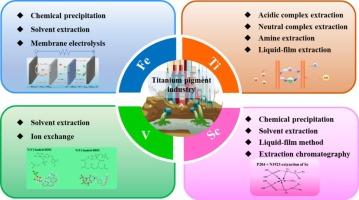Critical metals recovery from titanium dioxide waste acids (TDWA): A brief review
IF 5
2区 工程技术
Q1 ENGINEERING, CHEMICAL
引用次数: 0
Abstract
Titanium dioxide waste acid (TDWA) is an inevitable hazardous by-product in the titanium dioxide (TiO2) production. The substantial emission volume of TDWA, characterized by high acidity and diverse metal compositions, presents considerable risks of environmental pollution and resource wastage. The metals recovery from TDWA has emerged as a critical challenge for the green sustainable development of TiO2 industry. After literature analysis, numerous literatures are focused on the separation of a single metal. Therefore, this work systematically reviews the recovery technologies of simplex Fe, Ti, V, and Sc from TDWA, including the chemical precipitation, solvent extraction, ion exchange, liquid membrane separation, and membrane electrolysis. Moreover, the combined technologies for multi-metal separation, including multi-step selective extraction, co-extraction and step stripping, and extraction-precipitation combined technology, are also highlighted. Solvent extraction has good adaptability to multi-metals by using various extractants. Future research should prioritize the development of selective extractants and novel technologies for the separation of metals from the high-acidity and low-concentration systems. The synergistic recovery of critical rare metals such as niobium (Nb) and yttrium (Y) should also be concerned. This review provides guidance for the selection of appropriate methods for metal recovery from TDWA.

从二氧化钛废酸(TDWA)中回收关键金属综述
二氧化钛废酸是钛白粉生产过程中不可避免的有害副产物。TDWA具有酸性强、金属成分多样等特点,排放量大,环境污染和资源浪费风险大。从TDWA中回收金属已成为TiO2产业绿色可持续发展的关键挑战。经过文献分析,很多文献都集中在单一金属的分离上。因此,本文系统地综述了从TDWA中回收单晶Fe、Ti、V、Sc的技术,包括化学沉淀法、溶剂萃取法、离子交换法、液膜分离法和膜电解法。重点介绍了多步选择萃取、共萃取与步提、萃取-沉淀联合等多金属分离技术。溶剂萃取采用多种萃取剂,对多种金属具有良好的适应性。未来的研究应重点开发高酸性低浓度体系中金属的选择性萃取剂和新技术。关键稀有金属如铌(Nb)和钇(Y)的协同回收也应予以关注。本文综述为选择合适的方法从TDWA中回收金属提供了指导。
本文章由计算机程序翻译,如有差异,请以英文原文为准。
求助全文
约1分钟内获得全文
求助全文
来源期刊

Minerals Engineering
工程技术-工程:化工
CiteScore
8.70
自引率
18.80%
发文量
519
审稿时长
81 days
期刊介绍:
The purpose of the journal is to provide for the rapid publication of topical papers featuring the latest developments in the allied fields of mineral processing and extractive metallurgy. Its wide ranging coverage of research and practical (operating) topics includes physical separation methods, such as comminution, flotation concentration and dewatering, chemical methods such as bio-, hydro-, and electro-metallurgy, analytical techniques, process control, simulation and instrumentation, and mineralogical aspects of processing. Environmental issues, particularly those pertaining to sustainable development, will also be strongly covered.
 求助内容:
求助内容: 应助结果提醒方式:
应助结果提醒方式:


